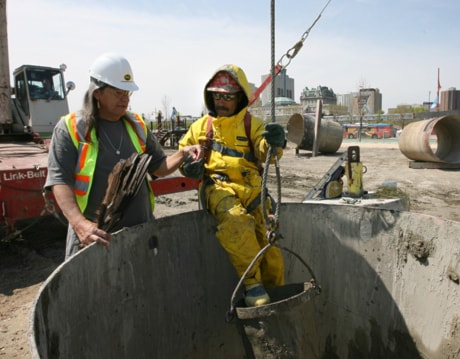WINNIPEG — Aboriginal elders are making sure that Mother Earth is on side with the construction of the Canadian Museum for Human Rights.
Every time construction crews drill into the ground, to allow the pouring of dozens of concrete caissons or the pounding of hundreds of piles to stabilize the museum’s foundation, a bag filled with aboriginal medicine is put into the bottom of the hole.
Keith Bousquet, a worker with Subterranean Ltd., the company that’s putting in the caissons and piles, said he has so far placed the medicine bags into about 20 holes.
“I’m Metis and this means a lot to me,” Bousquet said on Monday, shortly after emerging from a hole at least 50 metres deep.
“It’s a big honour and it’s a big privilege... someday I’ll be bringing my grandchildren here and telling them.”
Larry Monkman, an aboriginal elder with the council of elders at Thunderbird House, said they were pleased when museum officials asked how they could properly construct the building on land that once served as a historic meeting place for aboriginals.
“We told them, same as Thunderbird House, that before any pile is put in, the medicine must be put down,” Monkman said.
“It’s an ongoing sign of respect. It’s respect for Mother Earth and asking forgiveness for digging the holes.”
Monkman said every week he creates and blesses the medicine bags and delivers 21 of them to the construction site at The Forks.
“I put sage, sweetgrass, tobacco and cedar in. They’re our four main medicines,” he said.
“When they’re put in the hole we ask Mother Earth for her forgiveness for putting a hole into her.”
Monkman said the person putting the medicine in the hole has to have been drug- and alcohol-free for at least four days.
“I’d like to see it done at all construction sites. Any place is sacred where people have gathered.”
Todd Craigen, construction manager for PCL Constructors, said the addition of aboriginal medicine has not affected the construction.
“We’ve done work for aboriginal people before. We built Thunderbird House,” he said. “It has been incorporated into the work.”
Craigen said 134 caissons are being poured on the site as well as 378 piles. The depths vary from about 15 metres underground to 25 metres before reaching bedrock.
He said with the caissons, the medicine bag is put near the bottom of the hole, but with the piles, the bag is put on top of a two-metre-long base before the pile is hammered in from above.
Angela Cassie, a museum spokeswoman, said they recognized during the construction planning stage that they had to meet with the aboriginal community about the site.
“We recognize the importance of what this land represents to First Nations and Metis communities,” Cassie said.
